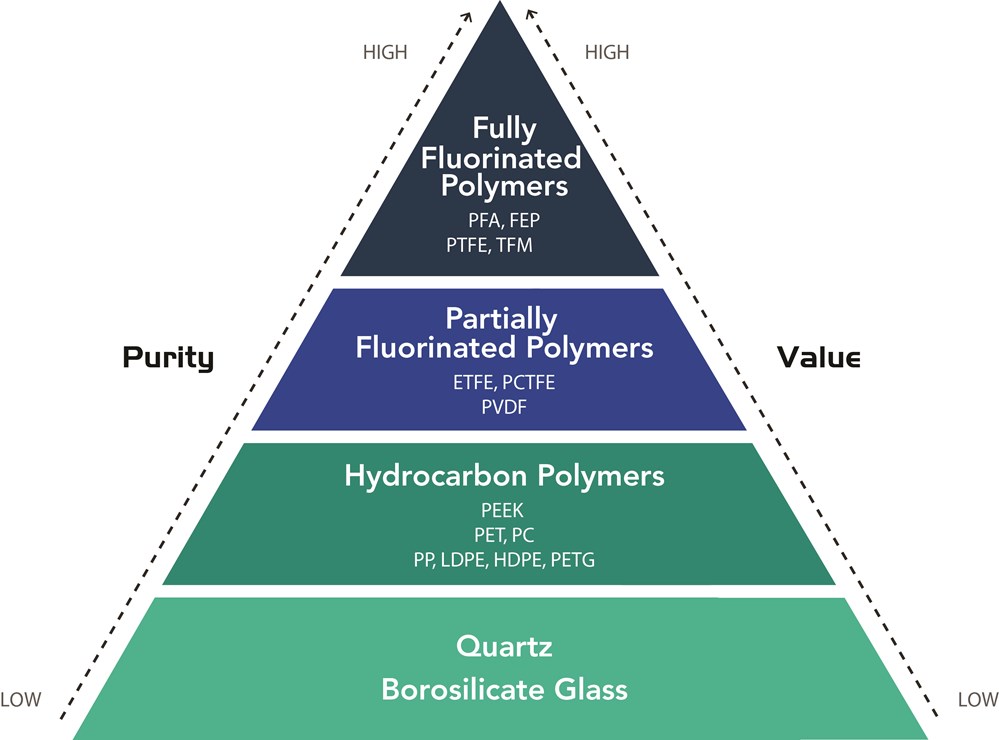FLUOROPOLYMER RESIN
Enjoy Enhanced Chemical Resistivity with Custom Fluoropolymer Molding
Fluoropolymers can be broadly separated into two categories: melt processable and non-melt processable. Melt processable fluoropolymers, also referred to as thermoplastics, are manufactured into products by injection molding, blow molding or rotational molding. Non-melt processable fluoropolymers, as the name suggests, cannot be heated into a molten state for molding and must be either machined or compression molded. Savillex specializes in melt-processable fluoropolymers including PFA, FEP, PVDF, ETFE and manufactures high performance products with chemical resistivity by injection molding and stretch blow molding. Products made from non-melt processable fluoropolymers (PTFE and modified PTFE) are not manufactured by Savillex.
Savillex has supply agreements with both of the leading suppliers of fluoropolymer resin - Chemours™ and Daikin, and uses the highest purity grades of resin available from both companies in the manufacture of Savillex products, and for your own fluoropolymer injection molding needs
A description of the properties and performance of the commonly used fluoropolymers if given below. Physical characteristics of each of the resins listed below is given in the Resin Comparison Chart.
Melt Processable Fluoropolymers
PFA
PFA has some unique properties which make it the only choice for many critical applications, including plastic bottles manufacturing. It has the widest wide working temperature range of any fluoropolymer, is inert to virtually every chemical, has very high lubricity and non-stick properties, and is available in very high purity grades (ultra-low organic extractables and trace metal content). PFA is translucent in appearance. It is widely used in the semiconductor industry and also used in sample preparation systems for trace metals analysis. One drawback is that it cannot be sterilized by irradiation (it must be steam sterilized, which is less convenient).
Compared to PTFE, PFA has a significantly higher dielectric strength. It also has greater creep resistance and can be welded using IR heat, which offers much greater fabrication possibilities. Savillex can mold PFA products in various grades of PFA resin depending on the requirements of the application. If ultimate freedom from trace metal content is not required, then use of a slightly lower grade of resin saves cost and reduces part price. At Savillex we routinely test resin for over 60 elements at ultratrace levels and can recommend the most appropriate grade for every application. PFA is an excellent choice for many fluoropolymer injection molding needs.
FEP
FEP has very similar properties to PFA and in some cases can be a direct alternative. Like PFA, FEP has great chemical resistivity, very high lubricity and non-stick properties, and is available in very high purity grades (ultra-low organic extractables and trace metal content). The main differences are a lower maximum working temperature range (200oC vs 260oC for PFA), and lower cost. FEP is also less translucent than PFA, being almost transparent. Savillex uses the highest purity grades of FEP resin which has very similar trace metals content to high purity PFA. Lower purity grades of FEP are widely used in wire and cable applications.
PVDF
PVDF (KynarTM) has a narrower working temperature range than PFA and PTFE and is less chemical resistant (it can in fact be dissolved in polar solvents). It is available in high purity (low metals) grades, but not as high purity as PFA or FEP. It is however very strong with a high impact strength and has excellent resistance to tensile creep. A benefit for biopharma applications is that it is gamma stable and can therefore be sterilized by irradiation. It is widely used in automotive and Li battery applications, and also in semiconductor and biopharma. It is also approved for food use.
ETFE
ETFE (TefzelTM) does not quite have the chemical resistance or the ultra-low metals content of PFA/FEP. It is, however, hard, has high tensile strength and good abrasion resistance. Working temperature range is wide – close to FEP. Traditionally used in wire and cable, a new application of ETFE is in bioprocessing where it’s wide temperature range, combined with gamma stability (for sterilization) makes it uniquely suited for low temperature storage of bulk drug substance.
Materials Comparison
ECTFE
ECTFE (HalarTM) does not quite have the chemical resistance or the ultra-low metals content of PFA/FEP. Like PVDF, It is very strong with a high impact strength, and has good mechanical properties, and very high surface smoothness. It is virtually transparent. Anti-stick properties are better than PVDF and closer to PFA. It is gamma stable and can therefore be sterilized by irradiation, which is a benefit for biopharma. Its working temperature range is narrower than PFA and FEP.
PCTFE
PCTFE does not quite have the chemical resistance or the ultra-low metals content of PFA/FEP. It is hard and strong and can be formed into transparent sheet. This combined with excellent barrier properties (gas and moisture) makes it ideal for pharma product packaging. It is gamma stable and can therefore be sterilized by irradiation, which is also a benefit for biopharma. Its working temperature range is narrower than PFA and FEP.
NON-MELT PROCESSABLE FLUOROPOLYMERS
Materials below are not injection moldable and not offered by Savillex but shown for comparison purposes.
PTFE
Like PFA, PTFE has a very wide temperature range, excellent lubricity and non-stick properties, and very high chemical resistance. Unlike PFA, PTFE is not melt processable and must be compression molded and/or machined. High purity grades of PTFE resin are not readily available (with the exception of modified PTFE in certain cases), and compression molding techniques are typically less “clean” than injection molding. When PTFE is purchased as rod stock prior to machining into the final part, trace metal purity is essentially unknown. There are many suppliers of PTFE resin, with very widely differing levels of metals content. The machining steps involved in manufacturing PTFE parts can add significant metal contamination. PTFE is widely used in industrial and consumer products. Although PTFE is also widely used in the semiconductor industry, PFA is used for applications where trace metals content is important.
Modified PTFE
Modified PTFE (sometimes referred to as TFM) has lower porosity compared to PTFE. However, porosity is still much higher than injection molded products. Other properties are similar to PTFE. The machining steps involved in manufacturing parts from modified PTFE can add significant metal contamination.
WHAT IS TEFLONTM
TEFLON™
The name TEFLON™ is often used incorrectly when referring to products made from fluoropolymers. For example, it is common to see the terms Teflon bottle, Teflon vial, Teflon cap etc. in scientific literature. In addition, many people assume that TEFLON™ is PFA. In fact, TEFLON™ is a registered trademark of Chemours™ (formerly known as DuPont), and refers to all fluoropolymer resins (PFA, FEP and PTFE) manufactured by Chemours™. A product such as a PFA bottle may only be called a TEFLON™ bottle if it is manufactured from TEFLON™ resin.
NEOFLON™
In a similar way, NEOFLON™ is a trademark of Daikin Industries Ltd. and is the product name for a wide range of fluoropolymer resins manufactured by Daikin. Savillex has supply agreements with both Chemours™ and Daikin, and uses the highest purity resins available from both companies in the manufacture of Savillex products.
MELT PROCESSABLE FLUOROPOLYMERS
PFA
PFA has some unique properties which make it the only choice for many critical applications, including plastic bottles manufacturing. It has the widest wide working temperature range of any fluoropolymer, is inert to virtually every chemical, has very high lubricity and non-stick properties, and is available in very high purity grades (ultra-low organic extractables and trace metal content). PFA is translucent in appearance. It is widely used in the semiconductor industry and also used in sample preparation systems for trace metals analysis. One drawback is that it cannot be sterilized by irradiation (it must be steam sterilized, which is less convenient).
Compared to PTFE, PFA has a significantly higher dielectric strength. It also has greater creep resistance and can be welded using IR heat, which offers much greater fabrication possibilities. Savillex can mold PFA products in various grades of PFA resin depending on the requirements of the application. If ultimate freedom from trace metal content is not required, then use of a slightly lower grade of resin saves cost and reduces part price. At Savillex we routinely test resin for over 60 elements at ultratrace levels and can recommend the most appropriate grade for every application. PFA is an excellent choice for many fluoropolymer injection molding needs.
FEP
FEP has very similar properties to PFA and in some cases can be a direct alternative. Like PFA, FEP has great chemical resistivity, very high lubricity and non-stick properties, and is available in very high purity grades (ultra-low organic extractables and trace metal content). The main differences are a lower maximum working temperature range (200oC vs 260oC for PFA), and lower cost. FEP is also less translucent than PFA, being almost transparent. Savillex uses the highest purity grades of FEP resin which has very similar trace metals content to high purity PFA. Lower purity grades of FEP are widely used in wire and cable applications.
PVDF
PVDF (KynarTM) has a narrower working temperature range than PFA and PTFE and is less chemical resistant (it can in fact be dissolved in polar solvents). It is available in high purity (low metals) grades, but not as high purity as PFA or FEP. It is however very strong with a high impact strength and has excellent resistance to tensile creep. A benefit for biopharma applications is that it is gamma stable and can therefore be sterilized by irradiation. It is widely used in automotive and Li battery applications, and also in semiconductor and biopharma. It is also approved for food use.
ETFE
ETFE (TefzelTM) does not quite have the chemical resistance or the ultra-low metals content of PFA/FEP. It is, however, hard, has high tensile strength and good abrasion resistance. Working temperature range is wide – close to FEP. Traditionally used in wire and cable, a new application of ETFE is in bioprocessing where it’s wide temperature range, combined with gamma stability (for sterilization) makes it uniquely suited for low temperature storage of bulk drug substance.
ECTFE
ECTFE (HalarTM) does not quite have the chemical resistance or the ultra-low metals content of PFA/FEP. Like PVDF, It is very strong with a high impact strength, and has good mechanical properties, and very high surface smoothness. It is virtually transparent. Anti-stick properties are better than PVDF and closer to PFA. It is gamma stable and can therefore be sterilized by irradiation, which is a benefit for biopharma. Its working temperature range is narrower than PFA and FEP.
PCTFE
PCTFE does not quite have the chemical resistance or the ultra-low metals content of PFA/FEP. It is hard and strong and can be formed into transparent sheet. This combined with excellent barrier properties (gas and moisture) makes it ideal for pharma product packaging. It is gamma stable and can therefore be sterilized by irradiation, which is also a benefit for biopharma. Its working temperature range is narrower than PFA and FEP.
NON-MELT PROCESSABLE FLUOROPOLYMERS
Materials below are not injection moldable and not offered by Savillex but shown for comparison purposes.
PTFE
Like PFA, PTFE has a very wide temperature range, excellent lubricity and non-stick properties, and very high chemical resistance. Unlike PFA, PTFE is not melt processable and must be compression molded and/or machined. High purity grades of PTFE resin are not readily available (with the exception of modified PTFE in certain cases), and compression molding techniques are typically less “clean” than injection molding. When PTFE is purchased as rod stock prior to machining into the final part, trace metal purity is essentially unknown. There are many suppliers of PTFE resin, with very widely differing levels of metals content. The machining steps involved in manufacturing PTFE parts can add significant metal contamination. PTFE is widely used in industrial and consumer products. Although PTFE is also widely used in the semiconductor industry, PFA is used for applications where trace metals content is important.
Modified PTFE
Modified PTFE (sometimes referred to as TFM) has lower porosity compared to PTFE. However, porosity is still much higher than injection molded products. Other properties are similar to PTFE. The machining steps involved in manufacturing parts from modified PTFE can add significant metal contamination.
WHAT IS TEFLONTM
TEFLON™
The name TEFLON™ is often used incorrectly when referring to products made from fluoropolymers. For example, it is common to see the terms Teflon bottle, Teflon vial, Teflon cap etc. in scientific literature. In addition, many people assume that TEFLON™ is PFA. In fact, TEFLON™ is a registered trademark of Chemours™ (formerly known as DuPont), and refers to all fluoropolymer resins (PFA, FEP and PTFE) manufactured by Chemours™. A product such as a PFA bottle may only be called a TEFLON™ bottle if it is manufactured from TEFLON™ resin.
NEOFLON™
In a similar way, NEOFLON™ is a trademark of Daikin Industries Ltd. and is the product name for a wide range of fluoropolymer resins manufactured by Daikin. Savillex has supply agreements with both Chemours™ and Daikin, and uses the highest purity resins available from both companies in the manufacture of Savillex products.





